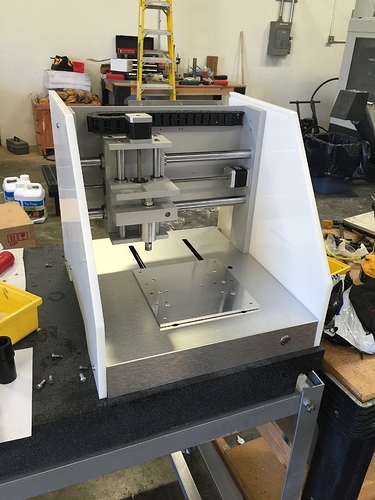Here’s the backstory:
Two months ago, Jorge send me a text, “You’d better come down here”, which, because it had no bad puns or inside jokes, seemed bad. Turns out that our linear rail vendor changed the order for 16mm rails to 20mm rails and we didn’t notice it on the invoice until they arrived. We now had $10k of unusable rails (1000 LBS or so).
Not even knowing how to get rid of them, we decided to change over to 20mm rails. We also had also been keeping a list of things we’d like to change, so we figured now would be the time:
- The old electronics were solid, but took too long to wire up.
- The old back panel worked well but waterjet parts cost a lot and we now had a mill of our own.
- Belts worked fine but there was too much assembly time and there were a couple of extra waterjet and machined parts that we could eliminate if we switched to lead screws.
- The frames were very rigid but we were paying a lot for machining and assembly. We were also dependent on a shop that could not meet our demand for frames We can make all but 4 parts in our own shop now.
- The old electronics cover was Dibond, and while it worked, we never really liked it. Sheet metal is almost equal in cost and less trouble. After spending lots and lots of money on Shapeoko parts, we now had a great sheet metal vendor to call.
- Use a custom extrusion for the frame to eliminate a number of machined parts.
- We’d also learned that shipping was not a big deal. We could add weight without affecting shipping in a big way.
One thing led to another and it’s a totally different machine on the inside. We can also make more of it in-house and not depend on other people.
If not for the $10k mistake we’d probably not have changed anything yet.
Production cost is in the same ballpark but we now have a machine we can build more quickly, and is better for the customer. Better is:
- More rigidity when pushing the limits of the machine (subject to spindle power)
- Better positioning accuracy
- Faster tool changes because of some of the assumptions we can make and because we changed the probe position.
@1st_Kiwi_Nomad- regarding lead screws, we’re using an anti-backlash nut, the same kind we’ve used on the Z for the last year. We’ve not seen any wear on the units we’ve been abusing here, so we feel good about using them for the X and Y now. If something weird came up with a customer unit, we’d have no problem sending out replacements.
@Randy is right that the 883 and 883 Pro are spindle-limited. The Pro is a solid upgrade but it’s not going to tear through material at 2x the rate. If we were Apple, we’d be better off calling this the “Nomad 883S”. If I remember right, I think my vote was for the “Nomad 883+”
FWIW, Jorge has been spending a lot of time with the spindle code in the last week to tighten it up for the next release. If we’re able to get any better performance from it, that’s something we can provide (somehow) to existing users. It’s gotten “smoother”, but it isn’t clear than mean anything when cutting parts yet.
Rob



 on the energy chain. That is one of the enhancements I’m planning for my own machine.
on the energy chain. That is one of the enhancements I’m planning for my own machine.